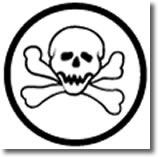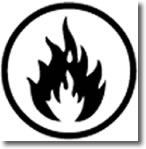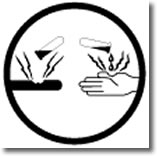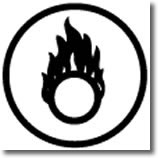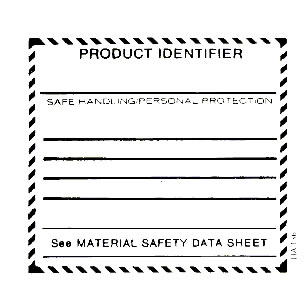- Introduction
- Supplier
- Sample Label
- Labels (Cont'd)
- Review #1
- Workplace
- Comparison
- Review #2
- Consumer
- Review #3
WHMIS Labels
WHMIS labels are affixed or attached to the containers of controlled products, and provide information that:
- Alerts the user to the hazards of the product
- States what precautions to take when handling the product.
- Refers the user to a material safety data sheet (MSDS) for more detailed information about the product.
The labels can be marks, signs, stamps, stickers, seals, tickets, tags or wrappers. They can be attached to, imprinted, stencilled or embossed on the controlled product or its container.
There are two specific types of labels outlined in WHMIS legislation:
Supplier Labels
Suppliers of WHMIS controlled products to workplaces in Canada, whether importing, producing, or selling these products, must affix a supplier label
Workplace Labels
Employers that produce controlled products in the workplace, or transport controlled products in a pipe, piping system or valves, must affix or attach a workplace label.
In addition, a workplace label must be placed on containers that are filled from suppliers' containers, and/or when a supplier label becomes illegible or is removed from the product.
Supplier LabelsSupplier labels must:
|
|
Supplier labels must include:1. Product IdentificationThe common name, chemical name, trade name, generic name, brand name, code name, or code number of a hazardous material 2. Hazard SymbolA specific WHMIS symbol that represents one or more of the hazard classifications that apply to the product 3. Risk PhraseA brief description of the hazard and the effects of harmful exposure to the body 4. Precautionary MeasuresBrief instructions for the safe use of the material 5. First Aid MeasuresA brief description of treatment for exposure to the material 6. Supplier IdentifierThe name of the suppler 7. Reference to the MSDSA statement indicating that a copy of the applicable MSDS is readily available in the workplace. |
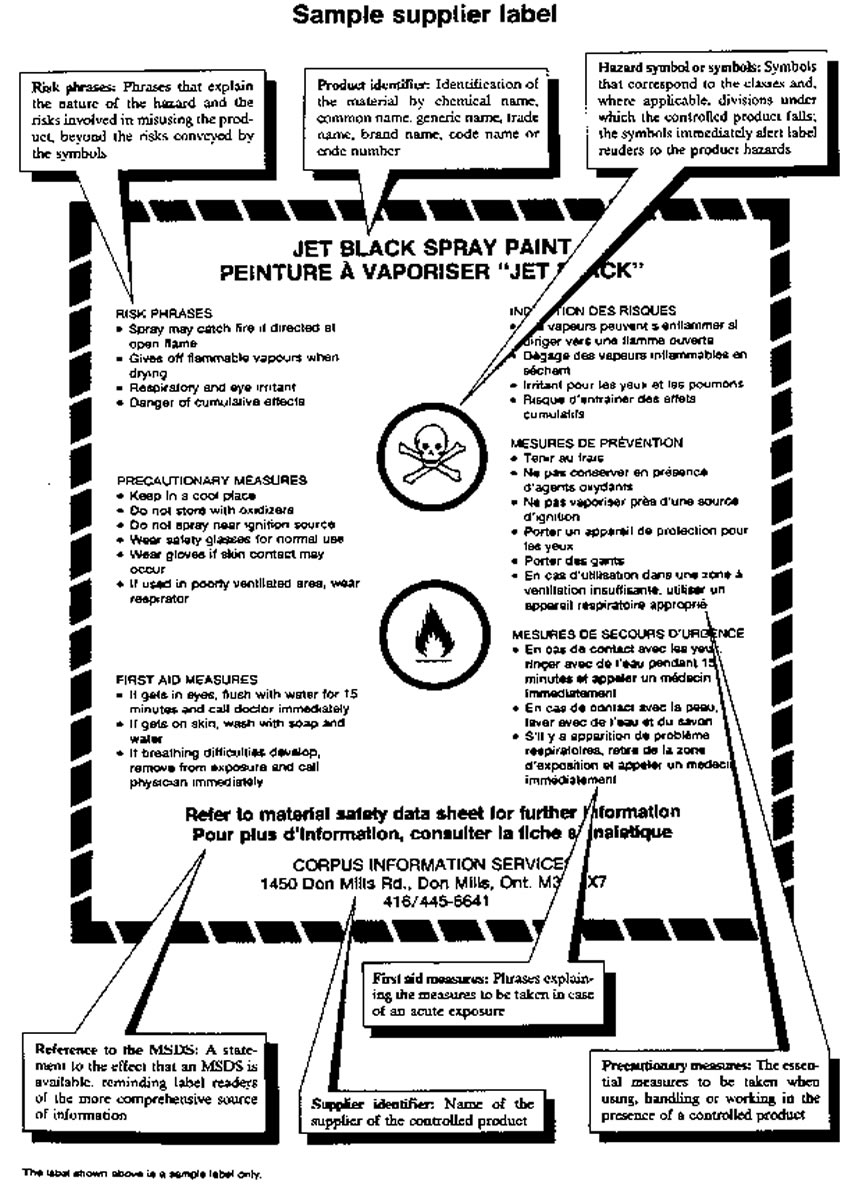
Graphic courtesy of the University of Manitoba
Supplier Labels ContinuedEach container of controlled materials in the workplace must have a WHMIS label. If a supplier does not provide a supplier label, the employers may not use the controlled product. It can be stored until a proper label is obtained. The employer is also responsible for ensuring supplier labels are not removed, altered or destroyed and that the material is used with the correct label attached. If a supplier label is accidentally lost or destroyed, and a spare supplier label for that product is not available, a workplace label may be used. |
|
Controlled products that are shipped in bulk follow special rules:
(See Workplace Labels for information about transferring bulk material into smaller containers.) |
There are five "self-test" questions for this section. If you think you're ready, go to Question 1 now. If you think you'd like another look at the content before you test yourself, go back to the beginning of the module.
- Q1
- Q2
- Q3
- Q4
- Q5
Question #1
You are working for Canadian Chemicals, a supplier of Alcohol. Design a Supplier Label by answering the following question.
What is the Product Identification?
Question# 2
You are working for Canadian Chemicals, a supplier of Alcohol. Design a Supplier Label by answering the following question.
What is the Supplier's Name?
a. Toronto Transit b. Ontario Hydro
Question #3
You are working for Canadian Chemicals, a supplier of Alcohol. Design a Supplier Label by answering the following question.
Select an appropriate symbol:
|
Question #4
You are working for Canadian Chemicals, a supplier of Alcohol. Design a Supplier Label by answering the following question.
The language of the label is:
a. English
b. English and French
c. Language of the workplace
d. Language used by the supplier.
Question #5
You are working for Canadian Chemicals, a supplier of Alcohol. Design a Supplier Label by answering the following question.
The border design is:
a. Diamonds b. Solid Black c. Cross-hatch d. No border
Workplace Labels
Workplace labels are designed and attached by the employer, and are required for:
- storage containers of controlled products produced on-site
- storage containers intended to receive bulk shipments (unless the supplier provides a label)
- portable containers into which product has been transferred
- supplier containers with illegible labels (unless a supplier label is available)
These labels must include:
1. Product Identification
The common name, chemical name, trade name, generic name, brand name, code name, or code number of a hazardous material
2. Safe Handling Instructions
This includes unique risks associated with the normal use of the controlled product and the possible emergencies.
3. Reference to the MSDS
A statement indicating that a copy of the applicable MSDS is readily available in the workplace
The employer may use other means of identifying hazardous materials in some cases. The information above must be included.
- Bulk Material
- Pipes
- Reaction Vessels
- Sign or placard
- Code letters and/or numbers
- Diagram or Process Flow Charts
The workplace label may be any size, shape or colour and there are no language requirements, but it must be clearly visible and easy to read.
The cross-hatch border, WHMIS symbols and phrases may appear on the workplace label, but they are not requirements.
Both of the labels pictured below are acceptable.
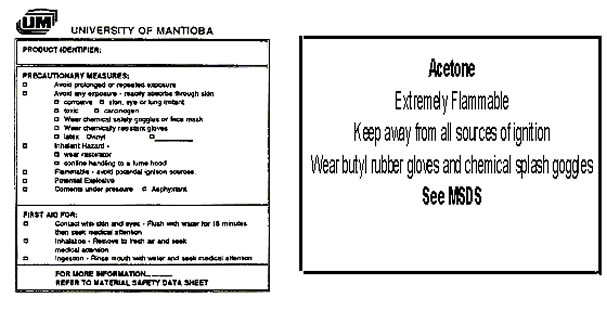
Comparison of Supplier and Workplace Labels
Supplier Label |
Workplace Label |
Provided by supplier |
Provided by employer |
Must appear on all controlled products:
|
Must appear on all controlled products:
|
Must include:
|
Must include:
|
Must have the cross-hatch border |
May contain WHMIS border or symbols, but not required |
Must be in both French and English |
No language requirement |
May be in other formats including placards, signs, codes, or diagrams. |
There are five "self-test" questions for this section. If you think you're ready, go to Question 1 now. If you think you'd like another look at the content before you test yourself, go back to the beginning of the module.
- Q1
- Q2
- Q3
- Q4
- Q5
Consumer Labels
The statutory mandate for the WHMIS and consumer product warning labels is contained in the Hazardous Products Act, an omnibus piece of federal legislation that was designed to ensure that products do not present a danger to the health and safety of the general public.
The act, administered by the Product Safety Branch of Health Canada, can be used to ban especially dangerous products from the marketplace, set performance standards for specific products and require the use of mandatory warning labels.
The scope of the Hazardous Products Act includes, among other things, consumer products that are poisonous, toxic, flammable, explosive, corrosive, infectious, oxidizing or reactive. The Hazardous Products Act establishes two separate but complementary sets of labelling requirements:
Labelling on consumer products uses "signal words", hazard statements and familiar pictograms to warn consumers about possible hazards to their lives and health.
There are four standardized warning signs:
- skeletal hand in the vat of acid which marks a corrosive;
- skull and crossbones for use on toxic products;
- exploding ball on explosives;
- open flame on flammables.
The shape of the border around the warning signs conveys the magnitude of the hazard.
- The octagonal "stop" sign means DANGER and is reserved for the most hazardous products.
- The "go-slow" diamond shape means WARNING and indicates a product that can cause serious injury.
- The inverted triangle of the "yield sign" means CAUTION and is used on products that could cause a minor injury if misused.
The pictograms are augmented by signal words, danger, caution or warning
Also included are primary and secondary hazard statements. The primary hazard statements refer to the most immediate or serious health threats, i.e., "harmful if absorbed through skin". The secondary hazard statements provide more detail on protective measures such, i.e. spill cleanup.
First aid information must also appear on the label in the event the product is swallowed, inhaled or splashed onto the skin or into the user's eyes.
These warnings must only appear on potentially hazardous chemical consumer products listed in the Hazardous Products Act.
There are five "self-test" questions for this section. If you think you're ready, go to Question 1 now. If you think you'd like another look at the content before you test yourself, go back to the beginning of the module.
- Q1
- Q2
- Q3
- Q4
- Q5
